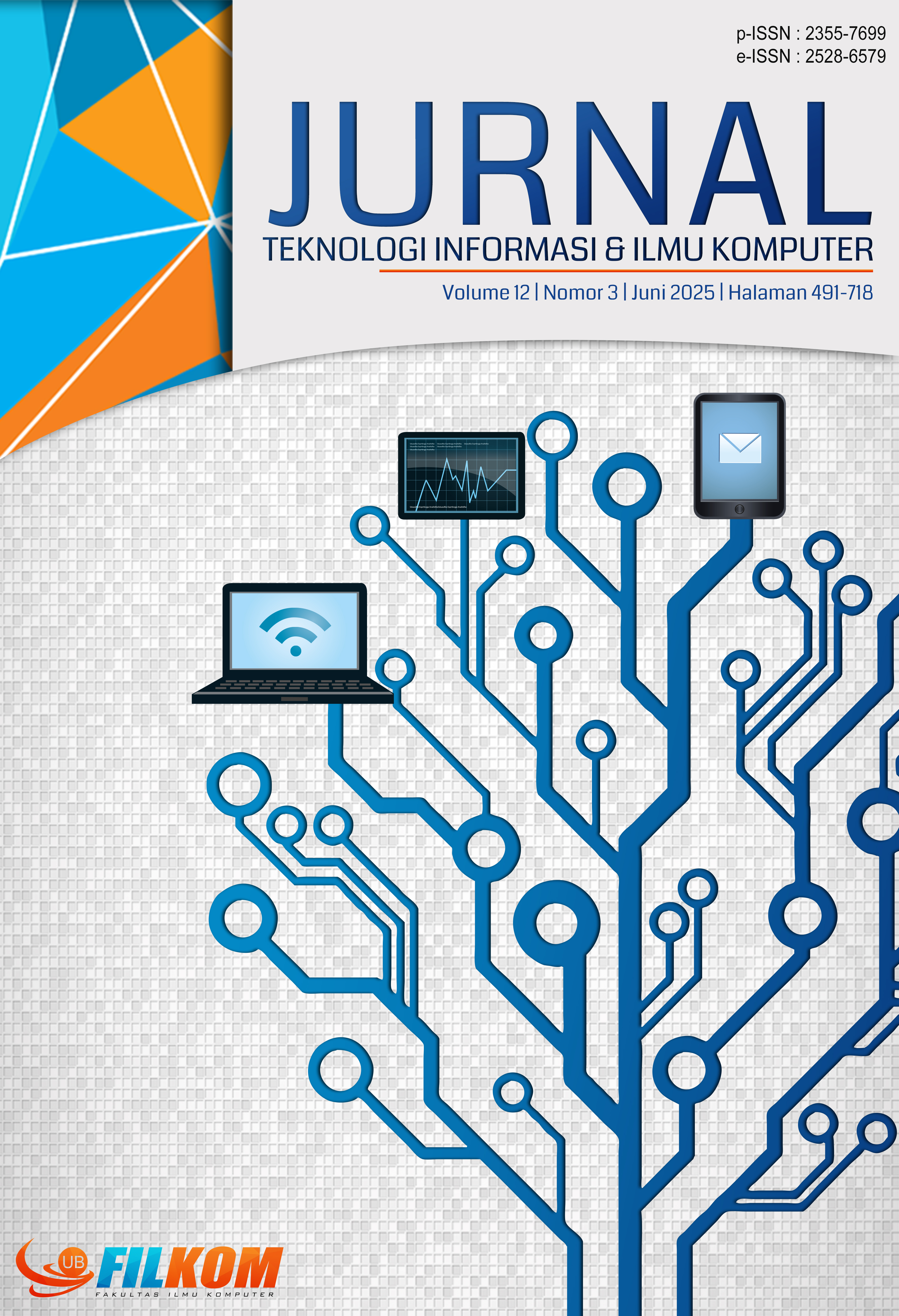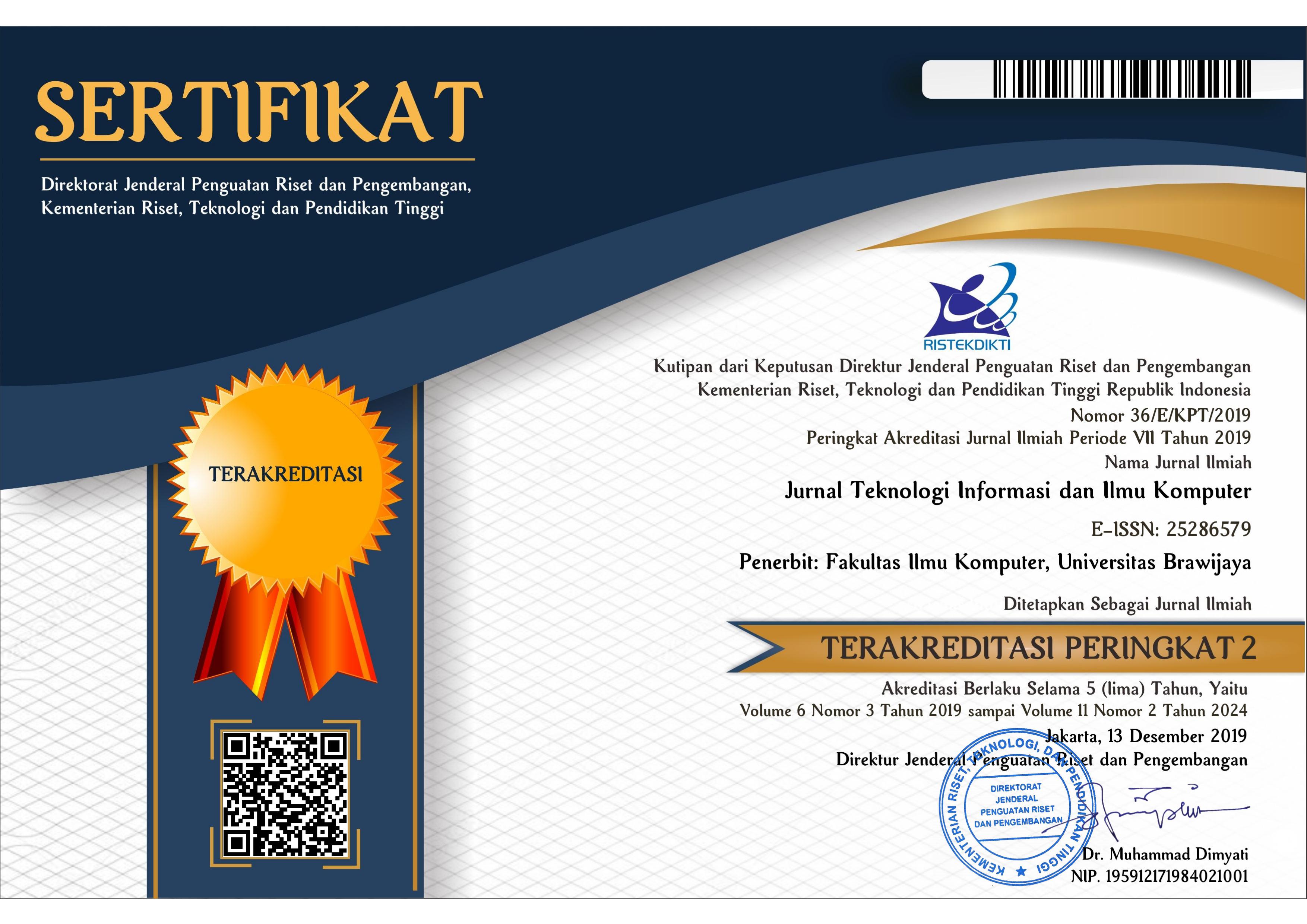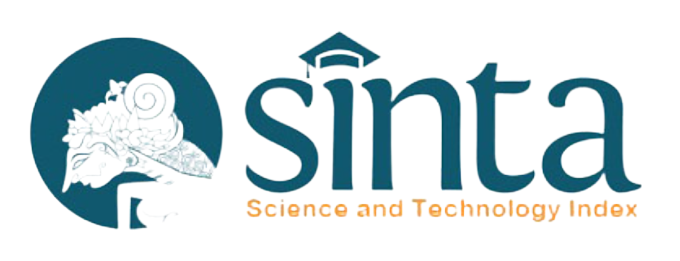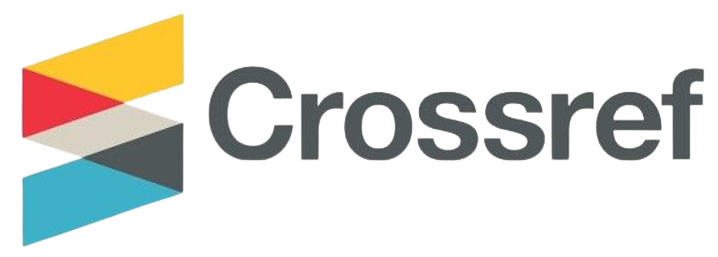Algoritma Enkripsi Dan Embedding Citra Digital Menggunakan Logistic Map-3 Dan Least Siginificant BIT
DOI:
https://doi.org/10.25126/jtiik.2025129400Kata Kunci:
Algoritma Embedding-Extracting, Algoritma Encryption-Decryption, Citra Digital, Least Significant BitAbstrak
Upaya pencegahan kebocoran atau pencurian data dan informasi digital dilakukan untuk menghindari penyalahgunaan oleh pihak ketiga yang menimbulkan berbagai kerugian. Pencegahan tersebut salah satunya dengan meningkatkan upaya keamanan data dan informasi melalui penerapan proses enkripsi dan dekripsi serta embedding dan ekstraksi (dalam dua tingkat pengamanan). Citra digital yang sudah dienkripsi (disandikan) sehingga menghasilkan citra yang tidak tampak (gambar yang blur atau berantakan). Selanjutnya agar tidak mencurigkan maka dilakukan tahapan pengamanan berikutnya yakni dengan disembunyikan (di embedding) pada citra lainnya yang bersifat umum. Teknik enkripsi yang digunakan dalam penelitian ini adalah fungsi chaos Logistic map-3 dan teknik penyisipan data Least Significant Bit-1 terhadap data berupa citra digital. Algoritma yang dirancang dalam paper ini adalah melakukan proses enkripsi dan embedding secara berurutan. Begitu pula untuk mendapatkan data dan informasi asli dilakukan dengan proses ekstraksi dan dekripsi secara berurutan. Hasil pengujian berdasarkan data pengujian yang digunakan pada paper ini menunjukkan bahwa data citra digital rahasia atau asli (secret image) telah berhasil dienkripsi dan disisipkan dengan baik, sehingga tidak dapat dikenali bahwa data gambar tersebut berisi data citra rahasia (secret image). Hal tersebut ditunjukkan dengan nilai PSNR nya tak hingga. Begitu pula dengan proses ekstraksi dan dekripsi yang berhasil dilakukan sehingga data citra rahasia (secret image) dapat diperoleh kembali dengan baik. Hal tersebut ditunjukkan dengan nilai PSNR nya tak hingga.
Abstract
Efforts to prevent leakage of digital data and information are carried out to avoid misuse by third parties that cause various losses. One of these preventions is by increasing the security of data and information through the application of encryption and decryption processes as well as embedding and extracting (in two levels of security). Digital images that have been encrypted (coded) so that they produce invisible images (blurry or messy images). Furthermore, so as not to be suspicious, the next security stage is carried out, namely by hiding (embedding) in other general images. The encryption technique used in this research is the chaos function of Logistic map-3 and the Least Significant Bit-1 data insertion technique. The algorithm designed is to perform the encryption and embedding processes sequentially. Likewise, to get the original data and information, it is done by sequentially extracting and decrypting processes. The test results based on the test data used, show that the original digital image data (secret image) has been successfully encrypted and embedded properly, so it cannot be recognized that the image data contains plain image data (secret image). This is indicated by the infinite PSNR value. Likewise, the extraction and decryption processes were successfully carried out so that the plain image data (secret image) could be retrieved properly. This is indicated by the infinite PSNR value.
Downloads
Referensi
AL-SHATNAWI A.M., 2012. A New Method in Image Steganography with Improved Image Quality, Applied Mathematical Sciences, 6 (79), 3907–3915.
ALANZY, MAY., ALOMRANI, R., ALQORNI, B., and ALMUTAIRI, Saad, 2023. Image Steganography Using LSB and Hybrid Encryption Algorithms, Applied Sciences, 13, 11771, 1-20.
https://doi.org/10.3390/app132111771
CETIN KAYA KOC, 2009. Cryptographic Engineering, Springer, New York.
CHAN, CHI-KWONG, and CHENG, 2024. L.M, Hiding data in images by simple LSB substitution, Pattern Recognition, 37, 469–474.
CHEN, LIQUN, and CHEN YU, 2012. The n-Diffie–Hellman problem and multiple-key encryption, International Journal Information Security, Springer, 11, 305–320.
DASGUPTA, K., MANDAL, J. K., and DUTTA, P., 2012. Hash Based Least Significant Bit Technique For Video Steganography (HLSB), Proceedings of International Journal of Security, Privacy and Trust Management, 1, 1–11.
DUE H NGUYEN, THUY T NGUYEN, TAN N DUONG, and PHOMH H PHAM, 2010. Cryptanalysis of MD5 on GPU Cluster, Proceedings of International Conference on Information Security and Artificial Intelligence, 2, 910–914.
EVA N and SURYADI MT., 2013. Chaos-Based Encryption Algorithm for Digital Image, Proceedings IICMA, 169–177.
GAO, H., ZHANG, Y., LIANG, S., and LI, D., 2006. A new chaotic algorithm for image encryption, Journal of Chaos, Solutons and Fractals, 29, 393–399.
HOSSAM ELDIN H AHMED, and AYMAN H, ABD EL-AZIEM., 2023. Image Encryption Using Development of Chaotic Logistic Map Based on Feedback Stream Cipher, Recent Advances In Telecommunications, Informatics And Educational Technologies, August, 274–283.
KOBLITZ, NEAL., 1998. Algebraic Aspects of Cryptography, Springer-Verlag Verlin Heidelberg, Germany.
MAGFIRAWATY, SURYADI MT, and RAMLI, K., 2010. Performance Analysis of zigzag map and hash function to generate random number, IEEE Xplore, DOI: 10.1109/ICELTICS.2017.8253286.
MENEZES, ALFRED J., VAN OORSCHOT, PAUL C., and VANSTONE, SCOTT A., 1996. Handbook of Applied Cryptography, CRC Press.
NAG, AMITAVA, BISWAS, S., SARKAR, D., SARKAR, P., 2010. A novel technique for image steganography based on Block-DCT and Huffman Encoding, International Journal of Computer Science and Information Technology, 2 (3), 1013-112.
PATIDAR, V., PAREEK, N.K., and SUD, K.K., 2009. A new subtitution-diffusion based image cipher using chaotic standard and logistic maps, Journal of Communications in Nonlinear Science and Numerical Simulation, 14, 3056–3075.
PAREEK, N. K., PATIDAR, V., and SUD, K. K., 2006. Image encryption using chaotic logistic map, Journal of Image and Vision Computing, 24, 926–934.
RAKSHIT, PRANATI., GANGULY, SREEPARNA., PAL, SOUVIK., and LE, DAC-NHUONG., 2021. Securing Technique Using Pattern-Based LSB Audio Steganography and Intensity-Based Visual Cryptography, Computers Materials & Continua, 67, Issue 1, 1207-1224.
SCHNEIER, BRUCE., 1996. Applied Cryptography: Protocols, Algorithms, and Source Code in C, 2nd ed. John Wiley & Sons.
SHIUH-JENG WANG., 2005. Steganography of capacity required using modulo operator for embedding secret image, Applied Mathematics and Computation, 164, 1613–1626.
STALLINGS, WILLIAM., 2011. Cryptography and Network Security: Principles and Practice, 5th edition, Pearson Education, Inc., Publishing as Prentice Hall., New Jersey.
SURYADI MT, NURPETI, E., and Widya, D., 2014. Performance of Chaos-Based Encryption Algorithm for Digital Image, TELKOMNIKA
Telecommunication, computing, electronics, and control, 12 (3), 675–682.
SURYADI MT, MARIA Y.T.I., and YUDI SATRIA., 2017. Encryption Algorithm using New Modified map for digital image, Journal of Physisc: Conference series, 893, IOP Publishing. doi: 10.1088/1742-6596/893/1/ 012050.
SURYADI MT, YUDI SATRIA, MELVINA, VENNY, PRAWADIKA, LUQMAN N and ITA M SHOLIHAT., 2020. A new chaotic map development through the composition of the MS Map and the Dyadic Transformation Map, Journal of Physics: Conference Series ICoMPAC, 1490, 01202.
SURYADI MT, YUDI SATRIA, and PRAWADIKA, LUQMAN N., 2020. An improvement on the chaotic behavior of the Gauss Map for cryptography purposes using the Circle Map combination, Journal of Physics: Conference Series ICoMPAC, 1490, 012045.
SURYANTO, Y., SURYADI MT, and RAMLI, K., 2016. A Secure and Robust Image Encryption Based on Chaotic Permutation Multiple Circular Shrinking and Expanding, Journal of Information Hiding and Multimedia Signal Processing, 7, 697–713.
SURYANTO, Y., SURYADI MT, and RAMLI, K., 2017. A New Image Encryption using color scrambling based on chaotic permutation multiple circuler shrinking and Expanding, Multimedia Tools and Applications, 76, 16831–16854.
VAJARGAH, B. F., and ASGHARI, R., A., 2015. Pseudo Random Number Generator Based on Chaotic Henon Map (CHCG), International Journal of Mechatronics, Electrical, and Computer Technology (IJMEC), 5 (15), 2120–2129.
WALIA, E., JAIN, P., and NAVDEEP., 2010. An Analysis of LSB & DCT based Steganography, Global Journal of Computer Science and Technology (GJCST Computing Classification), 10, Issue 1.
YANUAR, M.R., MT, SURYADI, APRIONO, C., and SYAWALUDIN, M.F., 2024. Image-to-Image Steganography with Josephus Permutation and Least Significant Bit (LSB) 3-3-2 Embedding, Applied Sciences, 14, 7119, 1-21.
https://doi.org/10.3390/app14167119
ZHANG, W., WONG, K., YU, H., and ZHU, Z., 2013. An Image Encryption Scheme Using Reverse 2-dimensional Chaotic Map and Dependent Diffusion, Journal of Communications in Nonlinear Science and Numerical Simulation, 18, 2066–2080.
ZHOU, Y., LOU, B., and CHEN, C.L.P., 2014. A New 1D Chaotic System for Image Encryption, Signal Processing, 97, 172–182.
Unduhan
Diterbitkan
Terbitan
Bagian
Lisensi
Hak Cipta (c) 2025 Jurnal Teknologi Informasi dan Ilmu Komputer

Artikel ini berlisensiCreative Commons Attribution-ShareAlike 4.0 International License.

Artikel ini berlisensi Creative Common Attribution-ShareAlike 4.0 International (CC BY-SA 4.0)
Penulis yang menerbitkan di jurnal ini menyetujui ketentuan berikut:
- Penulis menyimpan hak cipta dan memberikan jurnal hak penerbitan pertama naskah secara simultan dengan lisensi di bawah Creative Common Attribution-ShareAlike 4.0 International (CC BY-SA 4.0) yang mengizinkan orang lain untuk berbagi pekerjaan dengan sebuah pernyataan kepenulisan pekerjaan dan penerbitan awal di jurnal ini.
- Penulis bisa memasukkan ke dalam penyusunan kontraktual tambahan terpisah untuk distribusi non ekslusif versi kaya terbitan jurnal (contoh: mempostingnya ke repositori institusional atau menerbitkannya dalam sebuah buku), dengan pengakuan penerbitan awalnya di jurnal ini.
- Penulis diizinkan dan didorong untuk mem-posting karya mereka online (contoh: di repositori institusional atau di website mereka) sebelum dan selama proses penyerahan, karena dapat mengarahkan ke pertukaran produktif, seperti halnya sitiran yang lebih awal dan lebih hebat dari karya yang diterbitkan. (Lihat Efek Akses Terbuka).















